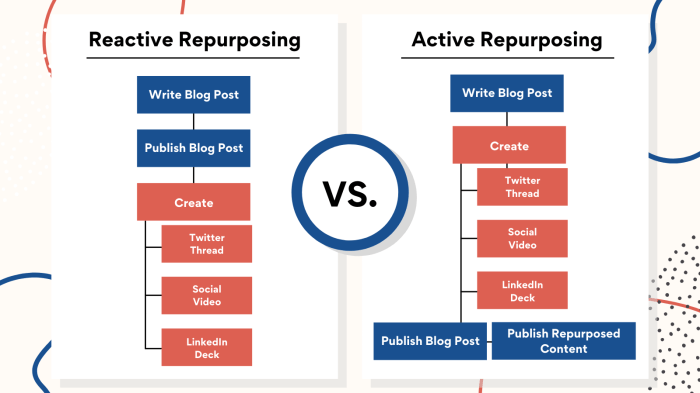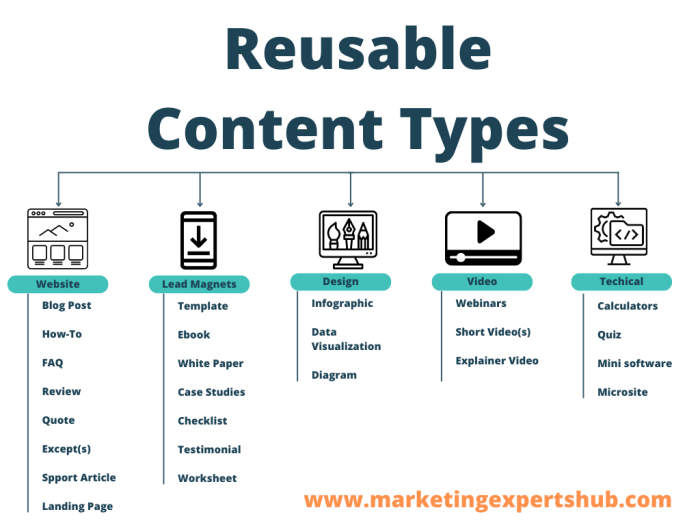Diving into Content Repurposing Techniques, get ready to learn how to breathe new life into your digital content. From blog posts to podcasts, we’ve got you covered with innovative strategies and tools to elevate your online presence.
Discover the art of repurposing content and watch your reach soar to new heights.
Content Repurposing Techniques
Content repurposing in digital marketing is the process of taking existing content and adapting it to different formats or platforms to reach a wider audience and maximize its value. Instead of creating new content from scratch, businesses can repurpose existing content to save time and resources while still engaging with their target audience.
Examples of Repurposed Content
- Turning a blog post into a podcast episode
- Creating an infographic from a research report
- Transforming a webinar into a series of short video clips
- Repurposing customer testimonials into social media posts
Benefits of Repurposing Content
Repurposing content offers several benefits for businesses, including:
- Extending the lifespan of content by reaching new audiences
- Improving by increasing the visibility of content across different platforms
- Enhancing brand consistency by reinforcing key messages through various formats
- Saving time and resources by leveraging existing content assets
Strategies for Repurposing Content

Repurposing content is a great way to maximize the reach and impact of your original work. By transforming blog posts, videos, and podcasts into different formats, you can engage with a wider audience and increase your content’s longevity.
Repurposing Blog Posts into Social Media Content
When repurposing blog posts into social media content, consider breaking down key points or quotes from the blog post into bite-sized pieces. Create engaging visuals to accompany the text and tailor the content to fit the platform you are sharing it on. You can also repurpose blog post images into Instagram posts or create Twitter threads based on the blog’s content.
Turning Videos into Blog Articles or Vice Versa
To turn videos into blog articles, transcribe the video content and use it as a basis for a written post. You can also create a blog post summarizing the key points discussed in the video. Conversely, if you have a well-received blog post, consider turning it into a video by creating a script based on the blog content and filming a video to visually represent the ideas.
Repurposing Podcasts into Infographics or Slideshows
Repurposing podcasts into infographics or slideshows involves extracting key points or quotes from the podcast episode and presenting them in a visual format. Create visually appealing graphics that highlight the main ideas discussed in the podcast. You can also use podcast audio clips as narration for slideshows or create infographic templates that summarize the podcast content in an easily digestible format.
Tools for Content Repurposing

When it comes to repurposing content, having the right tools can make all the difference in saving time and improving efficiency. Let’s take a look at some popular tools and software used for repurposing content.
Popular Tools for Repurposing Visual Content, Content Repurposing Techniques
- Canva: A user-friendly graphic design platform that allows you to create visually appealing graphics, presentations, and social media posts.
- Adobe Creative Cloud: Offers a suite of powerful design tools like Photoshop and Illustrator for advanced visual content creation and editing.
- Piktochart: Ideal for creating infographics, reports, and presentations with customizable templates and easy-to-use editing features.
- Snappa: An online graphic design tool with pre-made templates for social media graphics, blog images, and more.
Automation Tools for Streamlining the Content Repurposing Process
- Hootsuite: Allows you to schedule and automate social media posts across multiple platforms, saving time and ensuring consistent content distribution.
- Buffer: Another social media management tool that lets you schedule posts, analyze performance, and streamline content sharing.
- Zapier: Automates workflows by connecting various apps and tools, enabling seamless content repurposing processes through triggers and actions.
- MeetEdgar: A social media automation tool that recycles evergreen content, ensuring maximum visibility and engagement over time.
Maximizing Reach through Repurposed Content: Content Repurposing Techniques
Repurposing content is a great way to reach a wider audience and increase engagement. By optimizing your repurposed content for , promoting it across various platforms, and tracking its performance, you can ensure that your message reaches as many people as possible.
Optimizing for
Optimizing your repurposed content for is crucial for increasing visibility and driving traffic to your website or social media channels. Here are some tips to help you get started:
- Use relevant s strategically throughout your content.
- Create engaging and informative meta descriptions.
- Include internal and external links to reputable sources.
- Ensure your content is mobile-friendly and loads quickly.
- Regularly update and refresh your repurposed content to keep it relevant.
Promoting Across Platforms
Promoting your repurposed content across various platforms can help you reach different audiences and increase brand awareness. Here are some strategies to consider:
- Share your content on social media channels, such as Facebook, Twitter, and LinkedIn.
- Collaborate with influencers or other brands to amplify your message.
- Create visually appealing graphics or videos to accompany your content.
- Utilize email marketing to share your repurposed content with your subscribers.
- Participate in online communities and forums to share your content with relevant audiences.
Tracking Performance
Tracking the performance of your repurposed content is essential for understanding what resonates with your audience and improving future strategies. Here are some ways to track the performance of your content:
- Monitor website traffic and engagement metrics using tools like Google Analytics.
- Track social media metrics, such as likes, shares, and comments, to gauge audience interest.
- Use A/B testing to compare different versions of your content and determine what performs best.
- Solicit feedback from your audience through surveys or comments to gather insights for improvement.
- Set specific goals and KPIs for your repurposed content to measure success and make data-driven decisions.





